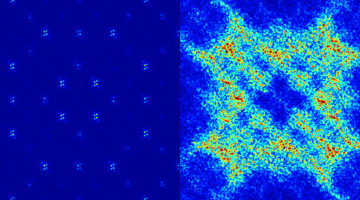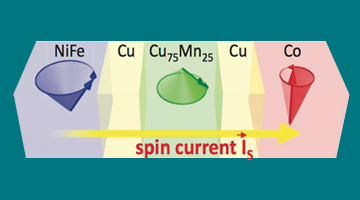Researchers designed and fabricated a nanomagnet array in which competing (“frustrated”) magnetic interactions can be directly tuned. Frustrated interactions are key to a wide range of phenomena, from protein folding and magnetic memory to fundamental studies of emergent exotic states. Read more »![]()
![]()
ALS Work Using XMCD
X-Rays Reveal ‘Handedness’ in Swirling Electric Vortices
Scientists used spiraling x-rays at the ALS to observe, for the first time, a property that gives handedness to swirling electric patterns—dubbed polar vortices—in a synthetically layered material. Read more »
Ferromagnetism Emerges to Alleviate Polar Mismatch
A polar mismatch between nonferromagnetic materials drives an electronic reconstruction in which interfacial ferromagnetism is induced. The emergence of such functionality at interfaces could enable new types of electronics for a range of applications, including logic, memory, sensing, and more. Read more »![]()
A New Way to Tune Emergent Magnetism
Perpendicular magnetic anisotropy (PMA)—where magnetic moments in a thin film preferentially point out of the plane of the film—is an emergent phenomenon of both fundamental and technological interest. A combination of x-ray techniques demonstrate how to tune PMA in transition-metal oxide multilayers. Read more »![]()
![]()
Electrical Switching of Magnetic Vortex Circulation
Photoemission electron microscopy (PEEM) experiments have demonstrated that the circulation direction of a magnetic vortex can be switched by the application of an electric field, opening the door to digital devices with more streamlined system designs, improved performance, and greater energy efficiency. Read more »![]()
![]()
How to Directly Probe ac Spin Currents
Scientists working at the ALS have made the first unambiguous, direct measurements of ac spin currents flowing through nanostructured metal layers. The work represents a crucial step toward the development of future spintronic devices that are smaller, faster, and more energy efficient. Read more »![]()
![]()
Signal Speed in Nanomagnetic Logic Chains
A time-resolved x-ray imaging technique directly observes signal propagation dynamics in nanomagnetic logic (NML) chains. The technique can assess NML reliability on fast time scales and help optimize chain engineering for this promising ultralow-power computing architecture. Read more »![]()
![]()






